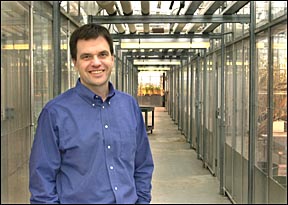|
|
|
|
|
|
INSIDE IOWA STATE March 9, 2001 Getting a head start on the "firsts"by Teddi BarronMost people don't go to Harvard to study plants. Not many Ph.D. students get their research published in Nature. And few associate professors' students start biotech companies. Yet, in about the same amount of time that it takes the rest of us to say Arabidopsis thaliana, spell Saccharomyces cerevisiae and define retrotransposon, Dan Voytas located the greenhouse at Harvard, made the first discovery of a particular genetic element in the aforementioned Arabidopsis plant, joined the zoology and genetics faculty at Iowa State and mentored a student whose own scientific breakthrough spawned a start-up company. It's an "odd history" says Voytas of his 25-year academic trek from a 4-H club in the north woods of Minnesota to a yeast genetics lab in the cornfields of Iowa by way of medical schools at Harvard and Johns Hopkins. The son of a forester, Voytas followed his childhood hobby of gardening to Harvard, where he earned an undergraduate degree in biology and a doctorate in genetics. Sometimes, the path was not well marked, however. "I actually spent my first year at Harvard in a bit of confusion. In some sense I was looking for sort of the 'land-grant side' of Harvard. I knew I wanted to study plants and work with plants, but I wasn't sure how to fit Harvard into that," Voytas said. He soon found the fit and his research passion: plant molecular biology, still in its infancy in the early 1980s. Voytas studies retrotransposons, a type of transposable element or mobile DNA that can replicate and insert into chromosomes. Roaming through chromosomes, transposons can cause mutations that create features like variegated leaves or provoke genetic diseases like cancer. Transposons are useful scientific tools for gene identification, gene transfer and the genetic characterization of a number of species. In medicine, retrotransposons can provide a key to understanding their cousins, retroviruses, which are used in human gene therapy and can cause disease (for example, AIDS). During graduate school, Voytas worked with Arabidopsis thaliana, a plant that would become a model research organism. At the time, however, little was known about its genetic make up. Voytas, searching for transposons because of their value in genetic analysis, was the first to find them in Arabidopsis. "I found a group of elements that are closely related to the retroviruses. At that time, they'd been described in animals and insects, but they were not known to be present in plant genomes," he said. His research was published in 1988 in Nature, one of the most distinguished research journals. While a postdoctoral fellow at Johns Hopkins University School of Medicine, and as a new faculty member at Iowa State, Voytas continued to study retrotransposons. However, he switched from Arabidopsis to Saccharomyces cerevisiae-- baker's yeast, an easier system to study. He searched for retrotransposons in the sequence data of yeast, the first non-bacteria whose genome had been completely sequenced. Once again, he discovered a new retrotransposon (called Ty5) and his findings were published in Nature. Voytas wanted to understand how Ty5 determines where in the chromosome to integrate. An important basic biological question, it also has medical applications. Retro-viruses are used in gene therapy because they are natural genetic engineers, inserting their DNA into chromosomes. "The goal of gene therapy is to eliminate genetic disease, and retroviruses can be manipulated to insert DNA that's therapeutic," Voytas said. However, retroviruses tend to integrate DNA randomly in the chromosomes. The key is to target precisely where to insert the DNA on the chromosomes. Delivery of a therapeutic gene could also create mutations in genes that are needed for other purposes. With research funding from the National Institutes of Health and the American Cancer Society, Voytas has made the first big step. "We've figured out how the retrotransposon works and we can manipulate it to integrate anywhere that we wish," he said. In another research project, Voytas and his former graduate student, David Wright, identified a group of genetic elements in the Arabidopsis genome data that had all the features of a retrotransposon. However, they have what appears to be an additional gene that is strikingly similar to the gene that distinguishes a retro-transposon from a retrovirus. "This was pretty exciting because retroviruses had long been studied in humans and vertebrates. In the mid-1990s there was some definitive evidence that retroviruses also existed in insects," Voytas said. "Now we have what appears to be retroviruses in plants -- a whole other kingdom in which they had never been described. "Now we're back in the lab, testing if these are, in fact, infectious viruses capable of being transmitted from plant to plant," he said. As in humans, plant retroviruses might be useful for delivering DNA. "We could perhaps use our targeting work to focus where they integrate on chromosomes and refine methods of viral DNA delivery," he said. Wright, who earned his Ph.D. in December, received funding from NIH and venture capital to start a company to research and develop retroviruses in plants. Equipped with the patents from Voytas' lab (for gene transfer by plant retroviruses, and the determinants of target specificity) Phytodyne opened in Ames in May 2000. "Dave's company is trying to move those findings from basic research into the real world to see if they have any applications. We still have considerable research and development ahead," Voytas said. "There's a lot of potential if Dave's retrovirus proves to be infectious."
|
|
Ames, Iowa 50011, (515) 294-4111 Published by: University Relations, online@iastate.edu Copyright © 1995-2001, Iowa State University. All rights reserved. |
